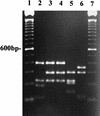PCR amplification of ribosomal DNA for species identification in the plant pathogen genus Phytophthora
- PMID: 9501434
- PMCID: PMC106350
- DOI: 10.1128/AEM.64.3.948-954.1998
PCR amplification of ribosomal DNA for species identification in the plant pathogen genus Phytophthora
Abstract
We have developed a PCR procedure to amplify DNA for quick identification of the economically important species from each of the six taxonomic groups in the plant pathogen genus Phytophthora. This procedure involves amplification of the 5.8S ribosomal DNA gene and internal transcribed spacers (ITS) with the ITS primers ITS 5 and ITS 4. Restriction digests of the amplified DNA products were conducted with the restriction enzymes RsaI, MspI, and HaeIII. Restriction fragment patterns were similar after digestions with RsaI for the following species: P. capsici and P. citricola; P. infestans, P. cactorum, and P. mirabilis; P. fragariae, P. cinnamomi, and P. megasperma from peach; P. palmivora, P. citrophthora, P. erythroseptica, and P. cryptogea; and P. megasperma from raspberry and P. sojae. Restriction digests with MspI separated P. capsici from P. citricola and separated P. cactorum from P. infestans and P. mirabilis. Restriction digests with HaeIII separated P. citrophthora from P. cryptogea, P. cinnamomi from P. fragariae and P. megasperma on peach, P. palmivora from P. citrophthora, and P. megasperma on raspberry from P. sojae. P. infestans and P. mirabilis digests were identical and P. cryptogea and P. erythroseptica digests were identical with all restriction enzymes tested. A unique DNA sequence from the ITS region I in P. capsici was used to develop a primer called PCAP. The PCAP primer was used in PCRs with ITS 1 and amplified only isolates of P. capsici, P. citricola, and P. citrophthora and not 13 other species in the genus. Restriction digests with MspI separated P. capsici from the other two species. PCR was superior to traditional isolation methods for detection of P. capsici in infected bell pepper tissue in field samples. The techniques described will provide a powerful tool for identification of the major species in the genus Phytophthora.
Figures







Similar articles
-
Single-strand-conformation polymorphism of ribosomal DNA for rapid species differentiation in genus Phytophthora.Fungal Genet Biol. 2003 Aug;39(3):238-49. doi: 10.1016/s1087-1845(03)00052-5. Fungal Genet Biol. 2003. PMID: 12892637
-
First Report of Phytophthora citrophthora Causing Fruit Brown Rot of Feijoa in Italy.Plant Dis. 2001 Jan;85(1):97. doi: 10.1094/PDIS.2001.85.1.97A. Plant Dis. 2001. PMID: 30832086
-
Rapid Detection of Phytophthora infestans in Late Blight-Infected Potato and Tomato Using PCR.Plant Dis. 1997 Sep;81(9):1042-1048. doi: 10.1094/PDIS.1997.81.9.1042. Plant Dis. 1997. PMID: 30861957
-
PCR amplification of species-specific DNA sequences can distinguish among Phytophthora species.Appl Environ Microbiol. 1994 Jul;60(7):2616-21. doi: 10.1128/aem.60.7.2616-2621.1994. Appl Environ Microbiol. 1994. PMID: 8074533 Free PMC article.
-
The oomycete broad-host-range pathogen Phytophthora capsici.Mol Plant Pathol. 2012 May;13(4):329-37. doi: 10.1111/j.1364-3703.2011.00754.x. Epub 2011 Oct 20. Mol Plant Pathol. 2012. PMID: 22013895 Free PMC article. Review.
Cited by
-
Incidence of endornaviruses in Phytophthora taxon douglasfir and Phytophthora ramorum.Virus Genes. 2010 Feb;40(1):130-4. doi: 10.1007/s11262-009-0421-7. Epub 2009 Nov 14. Virus Genes. 2010. PMID: 19915969
-
Genome-wide microsatellites and species specific markers in genus Phytophthora revealed through whole genome analysis.3 Biotech. 2020 Oct;10(10):442. doi: 10.1007/s13205-020-02430-y. Epub 2020 Sep 18. 3 Biotech. 2020. PMID: 33014685 Free PMC article.
-
PcMuORP1, an Oxathiapiprolin-Resistance Gene, Functions as a Novel Selection Marker for Phytophthora Transformation and CRISPR/Cas9 Mediated Genome Editing.Front Microbiol. 2019 Oct 22;10:2402. doi: 10.3389/fmicb.2019.02402. eCollection 2019. Front Microbiol. 2019. PMID: 31708886 Free PMC article.
-
Sterol-Sensing Domain (SSD)-Containing Proteins in Sterol Auxotrophic Phytophthora capsici Mediate Sterol Signaling and Play a Role in Asexual Reproduction and Pathogenicity.Microbiol Spectr. 2023 Feb 14;11(1):e0379722. doi: 10.1128/spectrum.03797-22. Epub 2023 Jan 11. Microbiol Spectr. 2023. PMID: 36629430 Free PMC article.
-
A Review of Living Collections with Special Emphasis on Sustainability and Its Impact on Research Across Multiple Disciplines.Biopreserv Biobank. 2017 Feb;15(1):20-30. doi: 10.1089/bio.2016.0066. Epub 2016 Nov 21. Biopreserv Biobank. 2017. PMID: 27869477 Free PMC article. Review.
References
-
- Benson D M. Detection of Phytophthora cinnamomi in azalea with commercial serological assay kits. Plant Dis. 1991;75:478–482.
-
- Bruns T D, White T J, Taylor J W. Fungal molecular systematics. Annu Rev Ecol Syst. 1991;22:525–564.
-
- Cooke D E L, Duncan J M. Phylogenetic analysis of Phytophthora species based on ITS 1 and 2 sequences of the rDNA gene repeat. Mycol Res. 1997;101:667–677.
-
- Duncan J. Fungal and bacterial diseases. Dundee, Scotland: Report of the Scottish Crops research Institute; 1995.
Publication types
MeSH terms
Substances
Associated data
- Actions
- Actions
LinkOut - more resources
Full Text Sources
Other Literature Sources

